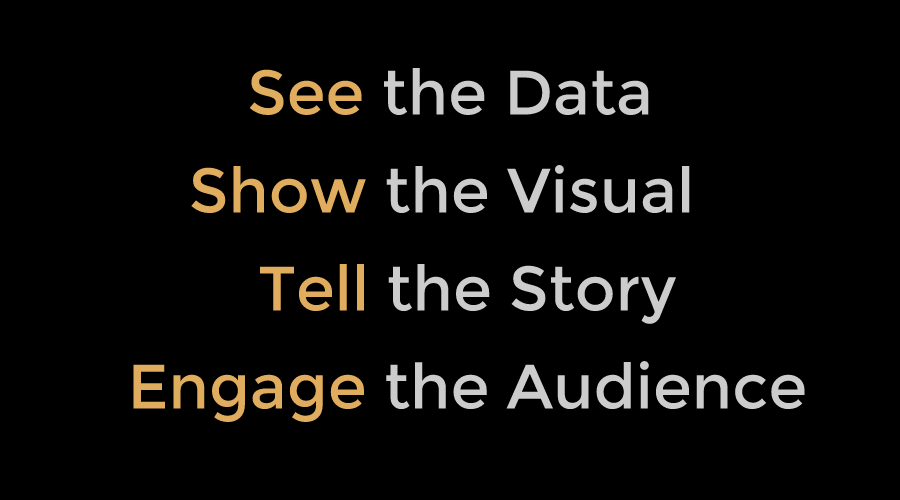Teaching Data Visualisation
See - Show - Tell - Engage.

I have had the opportunity to teach numerous sessions as a guest faculty at IIM Bangalore over the last three years. Most of them have centered on storytelling, analytics and data visualization. Last week, I had an another opportunity to facilitate a session on telling visual stories with data during the Visual Business Intelligence course at IIM Ahmedabad. Reflecting and parsing the feedback received over these sessions, I have developed some guides on teaching data visualization. This is mostly for my own learning as I finalize and launch a one-day workshop on this topic. But I thought about sharing it here, as it may be of interest to those teaching data visualization.
Use a simple framework.
It is useful to have a consistent simple framework (which is also jargon free) all through the session to guide the participant. I have developed the the See-Show-Tell-Engage as a way of guiding the telling visual stories with data sessions. I still need to fully anchor it with examples, but I am happy to continue to build on this foundation.
Focus on the basics.
It is important to spend a lot of time on teaching the basics. There is always a strong engagement, appreciation and recollection on the basics behind visual perception, table design and graphs design from the participants. I have learned a lot of these basic skills the very hard way during my strategy consulting apprenticeship. Teaching these basic skills is the most beneficial to the participant, as it can serve as a platform they can build on.
Tools matter.
It would great to teach visualization using only pen and paper (and I should do some more of it) but unfortunately tools do influence the data visualization thinking and workflow. It is clear that MS Office (with Excel and PowerPoint) is still the standard bearer tool for analytics and visualization. Clearly showcasing advanced visualization options using Excel and PowerPoint is of immediate benefit to the participants. There is also a need to address the coding vs. non-coding spectrum of the tools and their capabilities. Instead of focussing on one tool, I think showcasing the pros and cons of popular tool options for data handling, exploration, qualitative and quantitative visualization and mapping is more valuable.
Explore data more.
Building the basics in data preparation and data exploration through visualization is a must. Mostly this gets limited treatment as the data sets are already cleaned up, prepared and are fairly small that traditional techniques can be sufficient. In an half-day workshop, the focus always is on the show rather than the see. Also, it may be good to start this exploration with a tool agnostic approach, but I have to confess that I have not seen many. Most are done using a tool like Python/Matplotlib, Mondarian or Processing to illustrate the same. Ben Fry’s Visualising data has the Acquire-Parse-Filter-Mine-Represent-Refine-Interact which can be a guide or I have experience with the hypothesis-driven approach from my consulting background. May be I need to think about using excel as a starting point and then building on it by using of more powerful visual tool.
Learn by doing.
There is no shortcut to learning data visualization without getting your hands dirty with the data. Most of the concepts become clear only when the participants struggle to apply them on the project data-sets. Also, the design critique and feedback process after they do the presetantion appears to be very valuable for all participant. The trick here is to ensure the time spent on project work (and feedback) does not overshadow the time spent on concept learning. Using a singular rich data-set for the project work all through the sessions is one way to manage this.
Craft data-stories.
I spend a lot of time on teaching how to craft data-stories, as this is the core of what I want to combine and illustrate - data, visuals and stories altogether. I started by focussing primarily on the basics of (oral) storytelling, but have gradually reduced the time I spend on making them aware of their listening and observing faculties. I am now trying to bring in more concepts from other forms of storytelling like journalism, movies and comics to help the participant make an immediate connection to data-stories. The science here is still being developed so there is much to learn by teaching and experimenting with new ways to craft them. Also, I find that I need to be careful that the question and answers with the participant does not convert these session in to one focussed on presentation, communication and selling skills.
Go wide vs. deep.
I focus a lot on the explantory type of data-stories, but there is also a need on the exploratory data-stories and dashboard development. Given the number of questions I receive on improving engagement during quarterly / monthly review meetings, a session focussed on principles of good dashboard design would be valuable to the participants. Also, I confess to being more focussed on small-data in my session. Managing real-time data or big-data would be an useful addition but is more a technological issue, rather than something that would help elucidate new design principles.